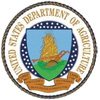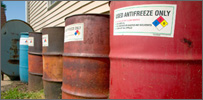Catalog of Environmental Programs 2012
| Federal agencies that contribute to EPA's environmental goals, and how they make a difference. |
the Catalog |
All Programs |
Programs by EPA Strategic Goal 1. Climate Change and Improving Air Quality 2. Protecting America's Waters 3. Cleaning Up and Sustainable Development 4. Safety of Chemicals and Preventing Pollution |
Programs by Agency AID, ARC, CNCS, CPSC, CSB, DHS, DOC, DOD, DOE, DOI, DOJ, DOL, DOS, DOT, ED, FHFA, GSA, HHS, HUD, NASA, NRC, NSF, OSTP, SBA, TVA, USDA, USPS, USTR, VA |

Department of Agriculture |

EPA Goal 4: Ensuring the Safety of Chemicals and Preventing Pollution |
Office of Pest Management Policy
Purpose
Established in September 1997, the USDA Office of Pest Management Policy (OPMP) is responsible for: (a)
integrating the Department's programs and strategic planning pertaining to pest management; (b)
coordinating the Department's role in the pesticide regulatory process and related interagency
affairs, primarily with the Environmental Protection Agency; and (c) strengthening the Department's
support for agriculture by helping to develop alternative pest management tools that may be needed
as a result of regulatory change. Currently the OPMP is most actively involved with implementation
of the 1996 Food Quality Protection Act (FQPA). Our role is two-fold: (1) provide the EPA with
information to help assure that pesticide tolerance reassessments are based on actual agricultural
practices and the most accurate data available; and (2) promote development of risk mitigation
plans and transition plans, commodity-by-commodity, to reduce the impact of
pesticide regulation.
Source(s) of Information
1. USDA: Office of Pest Management Policy
Related EPA Program(s)
Pesticides: Realizing the Value of Pesticide Availability:
Realizing the value of pesticide availability will be accomplished by implementing our statutes and taking regulatory actions to ensure public health
and socio-economic benefits of pesticide availability and use are achieved.
The Pesticide Environmental Stewardship program’s (PESP) efforts to increase adoption of Integrated Pest Management (IPM) in schools has led to a
substantial reduction in pest control costs and a reduction in both pesticide applications and pest problems in participating schools.
Laboratory activities for the pesticides program support the goal of protecting the environment from pesticide use through three pesticides
laboratories: an analytical chemistry laboratory, a microbiology laboratory at the Environmental Science Center at Fort Meade, MD, and an
environmental chemistry laboratory at Stennis Space Center, Bay St. Louis, MS.
Authorizing Legislation
• Federal Insecticide, Fungicide and Rodenticide Act (FIFRA)
• Federal Food, Drug and Cosmetic Act (FFDCA)
• Food Quality Protection Act (FQPA)
• Pesticide Registration Improvement Act (PRIA 2)
• Endangered Species Act (ESA)
Other Programs under Goal 4
Other Programs from USDA
Top of page


